Knowing what’s on cheese food labels is like finding a treasure map if you love cheese as much as I do. It tells us all about what’s inside that delicious package. So, grab a slice of your favorite cheese, and let’s learn together!
What’s on a Cheese Food Labels?
What info should be on cheese food labels?
Type of Cheese:
When you pick up a piece of cheese, the first thing you’ll notice on the label is the Type of Cheese.
Understanding Cheese Types
Cheddar
- Bold Words: Aged, Sharp, Mild
- Flavor Adventure: Cheddar takes you from smooth, mild tastes to bold, sharp flavors.
Mozzarella
- Bold Words: Fresh, Soft, Stretchy
- Flavor Adventure: Mozzarella is like a soft cloud of cheese goodness. It’s known for its mild taste and meltiness. Perfect on pizzas, it stretches into long, gooey strings that make your mouth water.
Brie
- Bold Words: Creamy, Earthy, Rich
- Flavor Adventure: Brie is the queen of soft cheeses. With its creamy inside and edible rind, it offers a rich, slightly earthy flavor. It’s a cheese that feels luxurious and is perfect for spreading on crackers.
Why Knowing Your Cheese Type Matters
- Taste Preferences: Knowing the type of cheese helps you choose according to what you like. Do you prefer something mild or with a stronger taste?
- Pairing with Foods: Some cheeses are perfect for cooking, while others, like Brie, are better served as they are with fruit or crackers.
- Exploring New Flavors: you can explore new flavors and textures.
The Importance of Cheese Types on Labels
Cheese labels serve as a mini-guide to help you make informed choices. By highlighting the type of cheese, they give you a hint about the flavor, texture, and best uses of the cheese.
Ingredients List
The Ingredients List on a cheese label is like a blueprint, revealing the foundation of what makes each cheese unique and delicious.
Breaking Down the Ingredients
Milk
- Bold Words: Cow, Goat, Sheep
- Why It’s Key: The type of milk used not only affects the flavor but also the texture and richness of the cheese. Goat’s milk brings a distinctive tartness, while sheep’s milk adds a rich, buttery taste.
Cultures
- Bold Words: Bacterial, Mold, Yeast
- Why It’s Key: These are the magic makers. Cultures help ferment the milk, turning it into cheese. They also play a huge role in developing the cheese’s unique flavor profile, texture, and even the holes in cheeses like Swiss.
Salt
- Bold Words: Sea Salt, Kosher Salt
- Why It’s Key: Salt does more than just add flavor. The type of salt can also make a subtle difference in the final taste.
Nutritional Information
The Nutritional Information on a cheese label giving you a quick snapshot of what you’re about to enjoy.
Let’s dive into why each of these elements is so important and how they affect your cheese choices.
Decoding the Nutritional Elements
Calories
- Bold Words: Energy, Serving Size
- Why It’s Key: The calorie content gives you an idea of how much energy you’re getting from a serving of cheese.
Fat
- Bold Words: Saturated, Unsaturated
- Why It’s Key: Cheese is known for its fat content, which contributes to its creamy texture and rich flavor. However, it’s important to differentiate between saturated and unsaturated fats.
Protein
- Bold Words: Muscle, Health
- Why It’s Key: Cheese is an excellent source of high-quality protein, essential for muscle repair and growth.
Expiration Date:
The Expiration Date on a cheese label, often marked as Best By or Use By, is more than just a date. It’s a guide to ensuring you enjoy your cheese at its peak quality and flavor.
- Best By: This date tells you when the cheese is expected to maintain its best flavor and quality. It’s not a hard deadline but a suggestion for when it will taste awesome.
- Use By: This is more about safety. Eating cheese past this date might not be a good idea, as it could affect the cheese’s taste and safety.
Why the Expiration Date is Crucial
- Taste and Quality: Cheese is all about the flavor. The expiration date helps you enjoy it when it’s just right, not too early or too late.
- Safety: Some cheeses can develop harmful bacteria over time. Adhering to the expiration date helps avoid any potential health risks.
- Waste Reduction: Knowing when your cheese is best enjoyed can help reduce food waste, encouraging you to eat it while it’s still good.
Tips for Handling Cheese
- Storage: Keep your cheese in the right conditions. Most cheeses like it cool and a bit humid.
- Trust Your Senses: If your cheese looks or smells odd, even before the expiration date, it’s best to avoid it.
- Freezing: Some cheeses can be frozen to extend their life, but remember this might change their texture.
Origin:
The Origin of a cheese, marked by Made in or simply Origin, tells a story of where it comes from. This could be a local farm a few miles away or a distant country known for its cheese-making traditions.
Why Knowing the Origin is Fascinating
- Taste Influences: The origin can influence the taste. Cheeses from different regions have unique flavors based on the local climate, diet of the cows (or goats or sheep), and traditional cheese-making practices.
- Cultural Connection: Cheese often carries with it centuries of tradition. Knowing where your cheese comes from connects you to that cultural heritage.
- Supporting Producers: Choosing cheeses based on their origin can also be a way to support local farmers or artisanal producers.
Exploring Cheese Origins
- Local vs. Imported: Try cheeses from different areas to compare how location influences taste.
- Traditions and Techniques: Researching the origin can reveal interesting facts about how the cheese is made.
- Sustainability: Consider the environmental impact of transporting cheese from far away and the benefits of supporting local producers.
Why Cheese Labels are Important
Cheese labels tell us lots of awesome stuff! They help us pick the best cheese for our health, find ones that fit what we can eat, and try new, yummy cheeses. Let’s explore these points in more detail.
Health Reasons:
- Allergy Info: If you can’t eat certain things, cheese labels are your best friends. For example, if regular milk bothers your stomach, you can find cheeses made from goat or sheep milk.
- Nutrition Facts: Cheese labels tell us how much fat, salt, and calories are inside.
Dietary Needs:
- Less Salt? No Problem!: Some of us need to eat less salt. Cheese labels can show us which cheeses have less salt, so we still get to enjoy cheese without worry.
- Vegan or Lactose-Free: Nowadays, you can find cheeses that everyone can eat, even if you’re vegan or can’t handle lactose. The label will tell you if it’s the right cheese for you!
Taste Adventure:
- Try New Cheeses: Want to taste cheese from different places? Cheese labels can be your treasure map to finding new and exciting cheeses from around the world.
- What Goes Well Together: Some cheese labels even suggest what food or drink tastes great with that cheese.
Fun Cheese Label Facts
Cheese labels aren’t just informative; they’re fun too!
How Old Is the Cheese?
- Aged Cheese: The label can tell you how long the cheese has been aged. The longer it’s aged, the stronger the flavor. This helps you choose if you want something strong or mild.
Color Codes on Labels
- Easy to Find: Some cheese labels use colors to help you quickly find what you’re looking for. For example, a blue label might mean it’s a bold-tasting blue cheese.
- Colors Tell You About Taste: The colors on the label can also give you a hint about the cheese’s taste. Bright colors for strong flavors and light colors for milder tastes.
Cheese Food Label Sample
Creating sample food labels for popular cheese products and dishes provides insight into the nutritional content and ingredients, helping everyone make informed dietary choices.
Here are 10 cheese food label samples, from classic cheeses to favorite snacks and meals.
1. Cottage Cheese Food Label
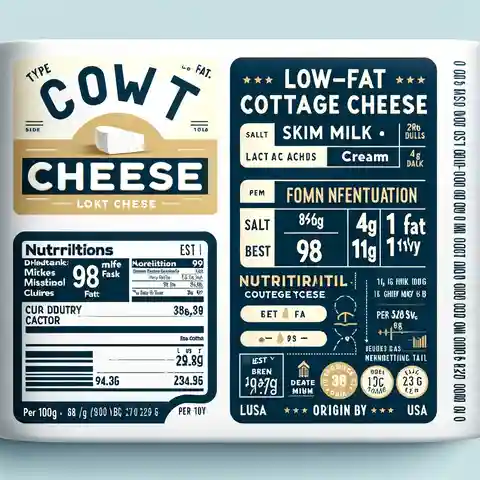
- Type of Cheese: Low-Fat Cottage Cheese
- Ingredients: Skim milk, cream, salt, lactic acid, cultures.
- Nutritional Information (per 100g): 98 calories, 4g fat, 11g protein.
- Best By: MM/DD/YYYY
- Origin: USA
2. Cream Cheese Food Label
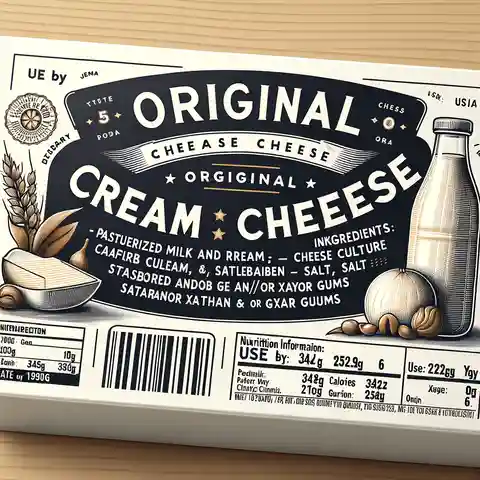
- Type of Cheese: Original Cream Cheese
- Ingredients: Pasteurized milk and cream, cheese culture, salt, stabilizers (carob bean and/or xanthan and/or guar gums).
- Nutritional Information (per 100g): 342 calories, 34g fat, 6g protein.
- Use By: MM/DD/YYYY
- Origin: USA
3. American Cheese Food Label
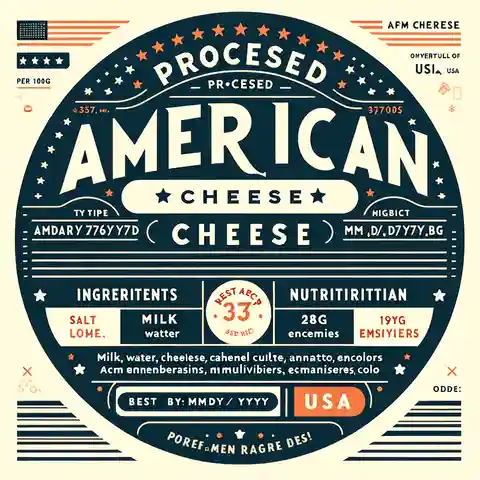
- Type of Cheese: Processed American Cheese
- Ingredients: Milk, water, cheese culture, salt, enzymes, annatto (color), emulsifiers.
- Nutritional Information (per 100g): 337 calories, 28g fat, 19g protein.
- Best By: MM/DD/YYYY
- Origin: USA
4. Cheeseburger Food Label (Restaurant Style)
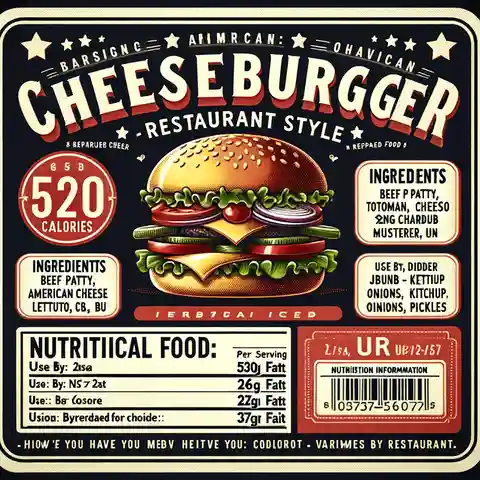
- Ingredients: Beef patty, American cheese, lettuce, tomato, bun, ketchup, mustard, onions, pickles.
- Nutritional Information (per serving): 530 calories, 26g fat, 27g protein.
- Use By: N/A (Prepared food)
- Origin: USA (Varies by restaurant)
5. Mac and Cheese Food Label (Homemade Recipe)
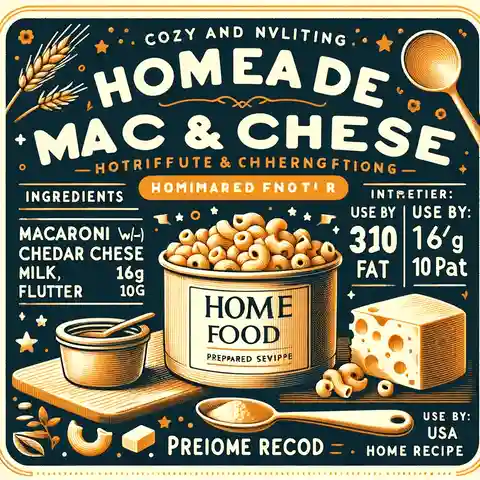
- Ingredients: Macaroni (wheat), cheddar cheese, milk, butter, flour, salt, pepper.
- Nutritional Information (per serving): 310 calories, 16g fat, 10g protein.
- Use By: N/A (Prepared food)
- Origin: USA (Home recipe)
6. Cheez-Its Food Label
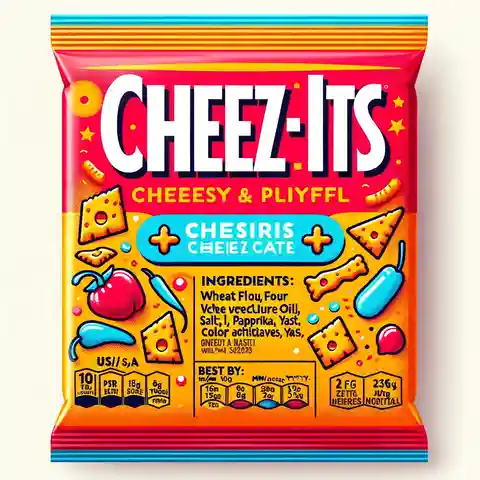
- Ingredients: Wheat flour, vegetable oil, cheese culture, salt, paprika, yeast, color additives.
- Nutritional Information (per 30g): 150 calories, 8g fat, 3g protein.
- Best By: MM/DD/YYYY
- Origin: USA
7. Kraft Mac and Cheese Food Label
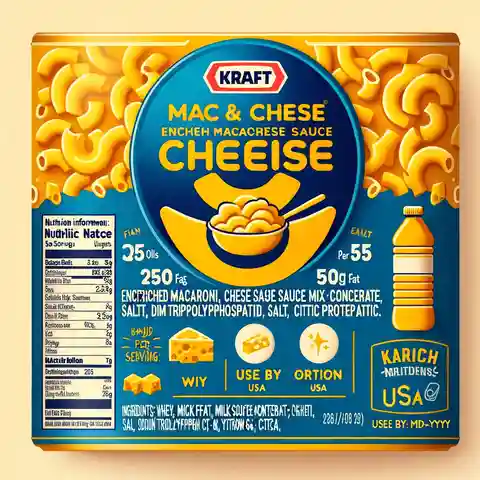
- Ingredients: Enriched macaroni, cheese sauce mix (whey, milkfat, milk protein concentrate, salt, sodium tripolyphosphate, citric acid, yellow 5 & 6).
- Nutritional Information (per serving): 250 calories, 3.5g fat, 9g protein.
- Use By: MM/DD/YYYY
- Origin: USA
8. Cheddar Cheese Food Label
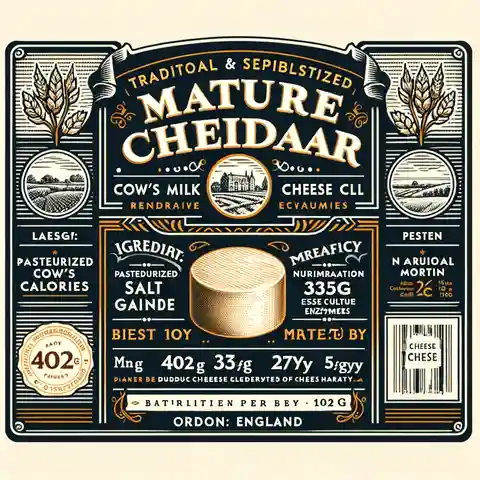
- Type of Cheese: Mature Cheddar
- Ingredients: Pasteurized cow’s milk, salt, cheese culture, enzymes.
- Nutritional Information (per 100g): 402 calories, 33g fat, 25g protein.
- Best By: MM/DD/YYYY
- Origin: England
9. String Cheese Food Label
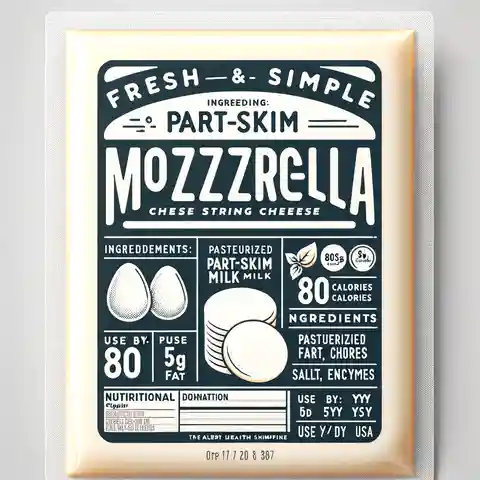
- Type of Cheese: Part-Skim Mozzarella
- Ingredients: Pasteurized part-skim milk, cheese cultures, salt, enzymes.
- Nutritional Information (per piece): 80 calories, 5g fat, 7g protein.
- Use By: MM/DD/YYYY
- Origin: USA
10. Velveeta Mac and Cheese Food Label
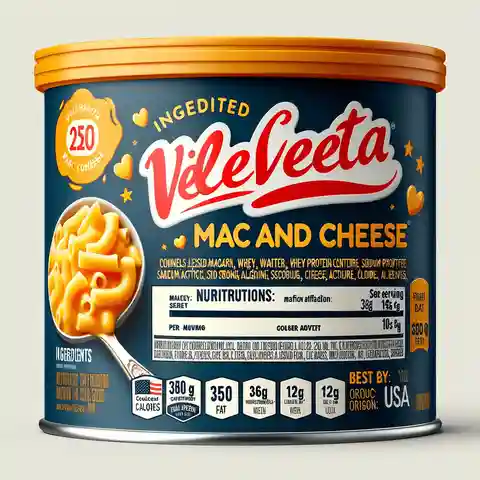
- Ingredients: Enriched macaroni, cheese sauce (milk, whey, water, whey protein concentrate, sodium phosphate, contains less than 2% of salt, lactic acid, sodium alginate, sorbic acid as a preservative, cheese culture, enzymes, color added).
- Nutritional Information (per serving): 360 calories, 12g fat, 10g protein.
- Best By: MM/DD/YYYY
- Origin: USA
These sample labels aim to provide a snapshot of what you might find when looking at various cheese products and dishes, allowing for better nutritional understanding and decision-making.
Conclusion
Cheese Food Label are like mini guides to the world of cheese. They help us make smart choices, find cheeses that taste amazing, and avoid anything we might not like or can’t eat. Next time you pick up a cheese, take a moment to read the label. You might discover something new and delicious!
Remember, every piece of cheese has a story, and its label is the first page. Happy cheese adventures!




